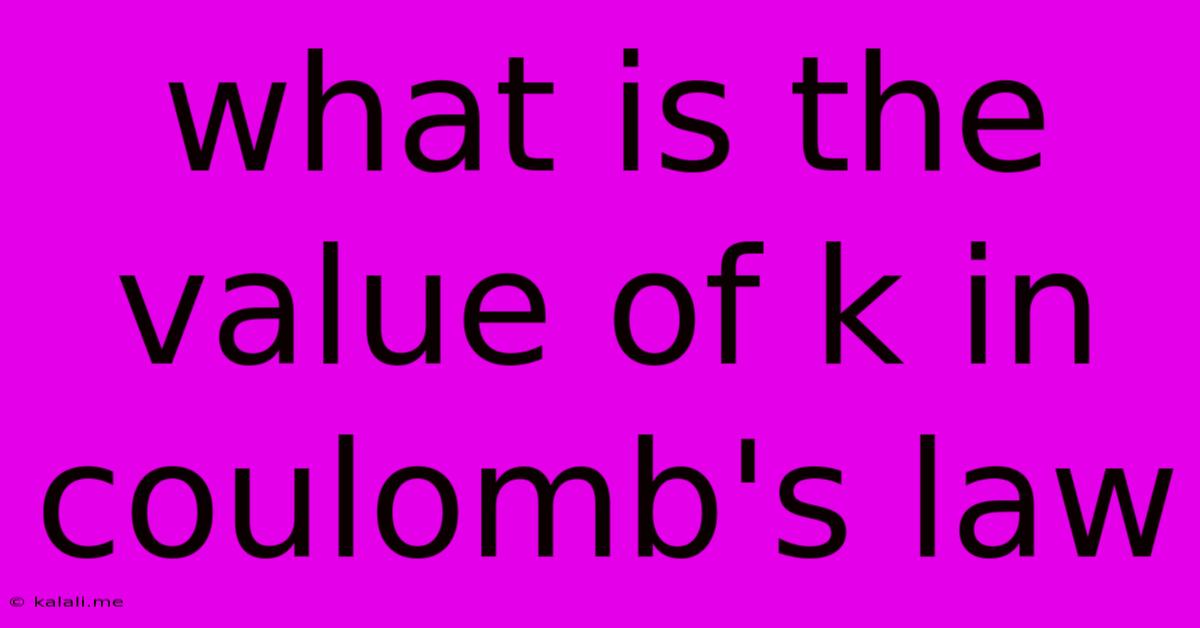What Is The Value Of K In Coulomb's Law
Kalali
Jun 14, 2025 · 3 min read

Table of Contents
What is the Value of k in Coulomb's Law? Understanding Coulomb's Constant
Coulomb's Law describes the fundamental force of attraction or repulsion between electrically charged particles. It's a cornerstone of electrostatics, crucial for understanding everything from the behavior of atoms to the workings of modern electronics. A key component of this law is Coulomb's constant, often represented by the letter 'k'. This article will delve into the meaning and value of k, exploring its significance and application.
Understanding Coulomb's Law
Before diving into the value of k, let's briefly review Coulomb's Law itself. The law states that the force (F) between two point charges is directly proportional to the product of the charges (q1 and q2) and inversely proportional to the square of the distance (r) between them. Mathematically, this is expressed as:
F = k * |q1 * q2| / r²
where:
- F represents the electrostatic force (in Newtons)
- k is Coulomb's constant
- q1 and q2 are the magnitudes of the two charges (in Coulombs)
- r is the distance between the charges (in meters)
- | | denotes the absolute value, indicating that the force is always positive, regardless of the charges' signs. The direction of the force is determined separately based on the signs of the charges (like charges repel, unlike charges attract).
The Significance of Coulomb's Constant (k)
Coulomb's constant, k, is a proportionality constant that reflects the strength of the electrostatic force in a given medium. Its value depends on the permittivity of the medium. In a vacuum (or, approximately, in air), the value of k is:
k ≈ 8.98755 × 10⁹ N⋅m²/C²
This value signifies the force between two charges of 1 Coulomb each separated by a distance of 1 meter in a vacuum. This incredibly large number reflects the immense strength of the electrostatic force at the scale of individual charges.
Variations in k: Permittivity and Dielectric Constants
The value of k changes when the medium separating the charges is not a vacuum. The constant is related to the permittivity (ε) of the medium by the following equation:
k = 1/(4πε₀)
where ε₀ is the permittivity of free space (vacuum). When a dielectric material is present, the permittivity changes, affecting the value of k. A dielectric constant (κ), a dimensionless quantity, describes how much the permittivity of a material differs from that of a vacuum:
ε = κε₀
Consequently, Coulomb's law in a dielectric medium can be written as:
F = (1/(4πε)) * |q1 * q2| / r² = k/κ * |q1 * q2| / r²
This means that the force between charges is reduced in a dielectric medium, and the effective value of k is k/κ, where κ is always greater than or equal to 1.
Applications of Coulomb's Law and k
Coulomb's law, with its constant k, is fundamental to many areas of physics and engineering:
- Atomic Structure: Understanding the forces holding atoms together.
- Chemical Bonding: Explaining the formation of molecules through electrostatic interactions.
- Materials Science: Predicting the properties of materials based on their charge distributions.
- Electronics: Designing circuits and electronic devices.
- Medical Imaging: Technologies like MRI utilize principles of electromagnetism, which are based on Coulomb's Law.
In conclusion, understanding the value and significance of k in Coulomb's Law is crucial for grasping the fundamental principles of electrostatics and its wide-ranging applications in numerous fields. The value of k in a vacuum is a fundamental physical constant, reflecting the strength of the electrostatic interaction, while its modified value in other media accounts for the influence of the surrounding material.
Latest Posts
Latest Posts
-
What Is The Difference Between Pounds And Kilograms
Jun 15, 2025
-
Which Of The Following Is An Incorrect Statement
Jun 15, 2025
-
Lcm Of 6 12 And 8
Jun 15, 2025
-
What Is Si Unit Of Frequency
Jun 15, 2025
-
The Unit Of Measurement For Sound Wave Frequency Is
Jun 15, 2025
Related Post
Thank you for visiting our website which covers about What Is The Value Of K In Coulomb's Law . We hope the information provided has been useful to you. Feel free to contact us if you have any questions or need further assistance. See you next time and don't miss to bookmark.